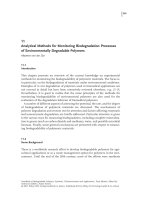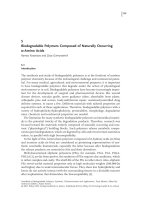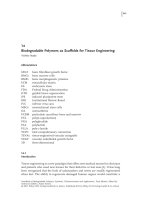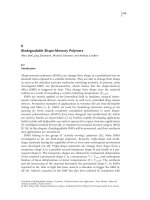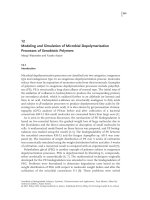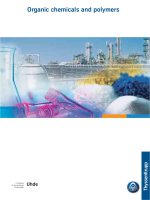Polymers (1)
Bạn đang xem bản rút gọn của tài liệu. Xem và tải ngay bản đầy đủ của tài liệu tại đây (15.04 MB, 520 trang )
9813_C000.fm Page i Friday, June 15, 2007 10:45 AM
9813_C000.fm Page ii Friday, June 15, 2007 10:45 AM
9813_C000.fm Page iii Friday, June 15, 2007 10:45 AM
J.M.G. COWIE
Heriot-Watt University
Scotland,UK
VALERIA ARRIGHI
Heriot-Watt University
Scotland,UK
CRC Press
Taylor & Francis Group
6000 Broken Sound Parkway NW, Suite 300
Boca Raton, FL 33487-2742
© 2007 by Taylor & Francis Group, LLC
CRC Press is an imprint of Taylor & Francis Group, an Informa business
No claim to original U.S. Government works
Version Date: 20140113
International Standard Book Number-13: 978-1-4200-0987-3 (eBook - PDF)
This book contains information obtained from authentic and highly regarded sources. Reasonable efforts
have been made to publish reliable data and information, but the author and publisher cannot assume
responsibility for the validity of all materials or the consequences of their use. The authors and publishers
have attempted to trace the copyright holders of all material reproduced in this publication and apologize to
copyright holders if permission to publish in this form has not been obtained. If any copyright material has
not been acknowledged please write and let us know so we may rectify in any future reprint.
Except as permitted under U.S. Copyright Law, no part of this book may be reprinted, reproduced, transmitted, or utilized in any form by any electronic, mechanical, or other means, now known or hereafter invented,
including photocopying, microfilming, and recording, or in any information storage or retrieval system,
without written permission from the publishers.
For permission to photocopy or use material electronically from this work, please access www.copyright.
com ( or contact the Copyright Clearance Center, Inc. (CCC), 222 Rosewood
Drive, Danvers, MA 01923, 978-750-8400. CCC is a not-for-profit organization that provides licenses and
registration for a variety of users. For organizations that have been granted a photocopy license by the CCC,
a separate system of payment has been arranged.
Trademark Notice: Product or corporate names may be trademarks or registered trademarks, and are used
only for identification and explanation without intent to infringe.
Visit the Taylor & Francis Web site at
and the CRC Press Web site at
9813_C000.fm Page v Friday, June 15, 2007 10:45 AM
Contents
Preface ..................................................................................................................... xv
The Authors .......................................................................................................... xvii
Chapter 1
Introduction .......................................................................................... 1
1.1
Birth of a Concept ......................................................................................... 1
1.2
Some Basic Definitions ................................................................................. 2
1.3
Synthesis of Polymers ................................................................................... 4
1.4
Nomenclature................................................................................................. 4
1.5
Average Molar Masses and Distributions ..................................................... 8
1.6
Size and Shape............................................................................................. 10
1.7
Configuration ............................................................................................... 12
1.8
The Glass Transition Temperature Tg and the Melting Temperature Tm .... 14
1.9
Elastomers, Fibers, and Plastics .................................................................. 16
1.10 Fiber-Forming Polymers.............................................................................. 18
1.11 Plastics ......................................................................................................... 18
1.12 Thermosetting Polymers.............................................................................. 21
1.13 Elastomers.................................................................................................... 21
Problems .................................................................................................................. 25
References................................................................................................................ 27
Bibliography ............................................................................................................ 27
Chapter 2
Step-Growth Polymerization.............................................................. 29
2.1
General Reactions........................................................................................ 29
2.2
Reactivity of Functional Groups ................................................................. 30
2.3
Carothers Equation ...................................................................................... 31
2.4
Control of the Molar Mass.......................................................................... 32
2.5
Stoichiometric Control of Mn ...................................................................... 34
2.6
Kinetics ........................................................................................................ 36
2.7
Molar Mass Distribution in Linear Systems............................................... 38
2.8
Average Molar Masses ................................................................................ 39
2.9
Characteristics of Step-Growth Polymerization.......................................... 40
2.10 Typical Step-Growth Reactions................................................................... 40
2.11 Ring Formation............................................................................................ 41
2.12 Nonlinear Step-Growth Reactions............................................................... 42
2.13 Statistical Derivation.................................................................................... 43
2.14 Comparison with Experiment...................................................................... 44
2.15 Polyurethanes............................................................................................... 46
2.16 Thermosetting Polymers.............................................................................. 49
Problems .................................................................................................................. 52
References................................................................................................................ 56
Bibliography ............................................................................................................ 56
9813_C000.fm Page vi Friday, June 15, 2007 10:45 AM
Chapter 3
Free-Radical Addition Polymerization .............................................. 57
3.1
3.2
3.3
3.4
Addition Polymerization.............................................................................. 57
Choice of Initiators...................................................................................... 57
Free-Radical Polymerization ....................................................................... 58
Initiators ....................................................................................................... 59
3.4.1
Initiator Efficiency......................................................................... 60
3.5
Chain Growth............................................................................................... 62
3.6
Termination .................................................................................................. 62
3.7
Steady-State Kinetics................................................................................... 63
3.8
High-Conversion Bulk Polymerizations...................................................... 65
3.9
Chain Transfer ............................................................................................. 67
3.9.1
Consequences of Chain Transfer .................................................. 70
3.10 Inhibitors and Retarders .............................................................................. 70
3.11 Activation Energies and the Effect of Temperature.................................... 72
3.12 Thermodynamics of Radical Polymerization.............................................. 73
3.13 Heats of Polymerization .............................................................................. 76
3.14 Polymerization Processes ............................................................................ 76
3.15 Features of Free-Radical Polymerization.................................................... 79
3.16 Controlled Radical Polymerization ............................................................. 79
3.17 Nitroxide-Mediated Polymerizations .......................................................... 81
3.18 Atom Transfer Radical Polymerization (ATRP) ......................................... 82
3.19 Reverse ATRP .............................................................................................. 83
3.20 Degenerative Chain Transfer Reaction (DT) .............................................. 84
3.21 Reversible Addition Fragmentation Chain Transfer (RAFT) ..................... 84
3.22 CRP of Vinyl Chloride ................................................................................ 87
3.23 The Kinetics of CRP Processes .................................................................. 87
3.24 Application to Experimental Data............................................................... 90
Problems .................................................................................................................. 92
References................................................................................................................ 96
Bibliography ............................................................................................................ 96
Chapter 4
4.1
4.2
4.3
4.4
4.5
4.6
4.7
4.8
4.9
4.10
4.11
4.12
Ionic Polymerization .......................................................................... 99
General Characteristics................................................................................ 99
Cationic Polymerization ............................................................................ 100
Propagation by Cationic Chain Carriers ................................................... 101
Termination ................................................................................................ 102
General Kinetic Scheme............................................................................ 103
Energetics of Cationic Polymerization...................................................... 103
Telechelic Polymers via Cationic Polymerization .................................... 104
Cationic Ring Opening Polymerization .................................................... 105
Stable Carbocations ................................................................................... 107
Anionic Polymerization............................................................................. 108
Living Polymers......................................................................................... 109
Kinetics and Molar Mass Distribution in Living Anionic Systems ......... 110
9813_C000.fm Page vii Friday, June 15, 2007 10:45 AM
4.13 Metal Alkyl Initiators ................................................................................ 114
4.14 Solvent and Gegen Ion Effects.................................................................. 114
4.15 Anionic Ring-Opening Polymerization..................................................... 114
Problems ................................................................................................................ 116
References.............................................................................................................. 118
Bibliography .......................................................................................................... 119
Chapter 5
Linear Copolymers and Other Architectures................................... 121
5.1
5.2
5.3
5.4
5.5
5.6
5.7
General Characteristics.............................................................................. 121
Composition Drift...................................................................................... 122
The Copolymer Equation .......................................................................... 122
Monomer Reactivity Ratios....................................................................... 123
Reactivity Ratios and Copolymer Structure ............................................. 124
Monomer Reactivities and Chain Initiation.............................................. 127
Influence of Structural Effects on Monomer Reactivity Ratios ............... 127
5.7.1
Resonance Effects ....................................................................... 127
5.7.2
Polar Effects ................................................................................ 129
5.8
The Q–e Scheme ....................................................................................... 129
5.9
Alternating Copolymers ............................................................................ 131
5.10 Block Copolymer Synthesis ...................................................................... 133
5.10.1 Transformation Reactions ........................................................... 135
5.10.1.1 Cationic to CRP......................................................... 137
5.10.1.2 Anionic to CRP ......................................................... 138
5.10.1.3 ROMP to ATRP......................................................... 139
5.10.1.4 Step-Growth ATRP.................................................... 139
5.10.2 Coupling Reactions ..................................................................... 140
5.10.3 Use of CRP Methods .................................................................. 142
5.11 Graft Copolymer Synthesis ....................................................................... 145
5.12 Statistical and Gradient Copolymers......................................................... 147
5.13 Complex Molecular Architectures............................................................. 148
5.14 Dendrimers................................................................................................. 149
5.14.1 Divergent Growth........................................................................ 150
5.14.2 Convergent Growth ..................................................................... 151
5.14.3 Dendrimer Molecular Weight ..................................................... 152
5.14.4 Properties of Dendrimers ............................................................ 153
5.14.5 Applications of Dendrimers........................................................ 154
Problems ................................................................................................................ 155
References.............................................................................................................. 156
Bibliography .......................................................................................................... 156
Chapter 6
6.1
6.2
6.3
Polymer Stereochemistry ................................................................. 157
Architecture ............................................................................................... 157
Orientation ................................................................................................. 157
Configuration ............................................................................................. 158
9813_C000.fm Page viii Friday, June 15, 2007 10:45 AM
6.3.1
Monotactic Polymers .................................................................. 159
6.3.2
Ditactic Polymers ........................................................................ 160
6.3.3
Polyethers .................................................................................... 160
6.4
Geometric Isomerism ................................................................................ 162
6.5
Conformation of Stereoregular Polymers ................................................. 163
6.6
Factors Influencing Stereoregulation......................................................... 165
6.7
Homogeneous Stereospecific Cationic Polymerizations........................... 167
6.8
Homogeneous Stereoselective Anionic Polymerizations.......................... 168
6.9
Homogeneous Diene Polymerization........................................................ 170
6.10 Summary.................................................................................................... 172
Problems ................................................................................................................ 172
References.............................................................................................................. 173
Bibliography .......................................................................................................... 173
Chapter 7
Polymerization Reactions Initiated by Metal Catalysts
and Transfer Reactions .................................................................... 175
7.1
7.2
7.3
7.4
7.5
7.6
7.7
7.8
7.9
7.10
7.11
7.12
7.13
7.14
Polymerization Using Ziegler–Natta Catalysts......................................... 175
Nature of the Catalyst ............................................................................... 176
Nature of Active Centers ........................................................................... 177
Bimetallic Mechanism............................................................................... 177
Monometallic Mechanism ......................................................................... 178
Stereoregulation ......................................................................................... 180
Ring-Opening Metathesis Polymerization (ROMP) ................................. 181
Monocyclic Monomers.............................................................................. 182
Bicyclo- and Tricyclomonomers ............................................................... 183
Copolyalkenamers ..................................................................................... 184
Living Systems .......................................................................................... 184
Group Transfer Polymerization (GTP) ..................................................... 186
Aldol Group Transfer Polymerization....................................................... 187
Metallocene Catalysts................................................................................ 188
7.14.1 Metallocene/Aluminoxane Catalysts .......................................... 189
7.14.2 Stereoregulation........................................................................... 189
7.14.3 Cationic Metallocenes................................................................. 192
7.14.4 Mechanism of Stereoregulation .................................................. 192
7.15 Concluding Remarks ................................................................................. 193
Problems ................................................................................................................ 194
References.............................................................................................................. 194
Bibliography .......................................................................................................... 194
Chapter 8
8.1
8.2
8.3
8.4
Polymers in Solution........................................................................ 197
Thermodynamics of Polymer Solutions.................................................... 197
Ideal Mixtures of Small Molecules........................................................... 197
Nonideal Solutions .................................................................................... 199
Flory–Huggins Theory: Entropy of Mixing.............................................. 199
9813_C000.fm Page ix Friday, June 15, 2007 10:45 AM
8.5
Enthalpy Change on Mixing ..................................................................... 203
8.6
Free Energy of Mixing .............................................................................. 204
8.7
Limitations of the Flory–Huggins Theory ................................................ 205
8.8
Phase Equilibria......................................................................................... 206
8.9
Flory–Krigbaum Theory............................................................................ 208
8.10 Location of the Theta Temperature ........................................................... 210
8.11 Lower Critical Solution Temperatures ...................................................... 213
8.12 Solubility and the Cohesive Energy Density ............................................ 216
8.13 Polymer–Polymer Mixtures....................................................................... 219
8.14 Kinetics of Phase Separation..................................................................... 223
Problems ................................................................................................................ 224
References.............................................................................................................. 227
Bibliography .......................................................................................................... 227
Chapter 9
Polymer Characterization — Molar Masses ................................... 229
9.1
9.2
9.3
9.4
9.5
9.6
9.7
Introduction................................................................................................ 229
Molar Masses, Molecular Weights, and SI Units ..................................... 229
Number-Average Molar Mass Mn ............................................................. 229
End-Group Assay....................................................................................... 230
Colligative Properties of Solutions ........................................................... 230
Osmotic Pressure ....................................................................................... 231
Light Scattering ......................................................................................... 234
9.7.1
Scattering from Large Particles .................................................. 236
9.8
Dynamic Light Scattering ......................................................................... 239
9.9
Viscosity..................................................................................................... 240
9.9.1
Viscosity-Average Molecular Weight ......................................... 242
9.10 Gel Permeation Chromatography.............................................................. 243
9.11 MALDI ...................................................................................................... 247
Problems ................................................................................................................ 248
References.............................................................................................................. 251
Bibliography .......................................................................................................... 252
Chapter 10 Polymer Characterization — Chain Dimensions, Structures,
and Morphology............................................................................... 253
10.1
10.2
10.3
10.4
10.5
Average Chain Dimensions ....................................................................... 253
Freely Jointed Chain Model ...................................................................... 254
Short-Range Effects................................................................................... 255
Chain Stiffness........................................................................................... 255
Treatment of Dilute Solution Data............................................................ 256
10.5.1 The Second Virial Coefficient..................................................... 256
10.5.2 Expansion Factor α ..................................................................... 257
10.5.3 Flory–Fox Theory ....................................................................... 258
10.5.4 Indirect Estimates of Unperturbed Chain Dimensions............... 259
10.5.5 Influence of Tacticity on Chain Dimensions .............................. 259
9813_C000.fm Page x Friday, June 15, 2007 10:45 AM
10.6
10.7
10.8
10.9
Nuclear Magnetic Resonance (NMR)....................................................... 260
Infrared Spectroscopy................................................................................ 262
Thermal Analysis....................................................................................... 264
Wide-Angle and Small-Angle Scattering.................................................. 265
10.9.1 Wide-Angle X-Ray Scattering .................................................... 266
10.9.2 Small-Angle X-Ray Scattering (SAXS) ..................................... 267
10.9.3 Small-Angle Neutron Scattering (SANS)................................... 268
10.10 Microscopy ................................................................................................ 271
10.10.1 Optical Microscopy ..................................................................... 272
10.10.2 Scanning Electron Microscopy ................................................... 273
10.10.3 Transmission Electron Microscopy............................................. 274
10.10.4 Atomic Force Microscopy and Scanning Tunneling
Microscopy .................................................................................. 274
Problems ................................................................................................................ 276
References.............................................................................................................. 277
Bibliography .......................................................................................................... 277
Chapter 11 The Crystalline State and Partially Ordered Structures .................. 279
11.1
11.2
11.3
11.4
11.5
11.6
11.7
11.8
11.9
11.10
11.11
11.12
11.13
Introduction................................................................................................ 279
Mechanism of Crystallization ................................................................... 279
Temperature and Growth Rate .................................................................. 281
Melting....................................................................................................... 282
11.4.1 Effect of Crystallite Size on Melting.......................................... 282
Thermodynamic Parameters ...................................................................... 282
Crystalline Arrangement of Polymers....................................................... 285
11.6.1 Factors Affecting Crystallinity and Tm........................................ 285
11.6.1.1 Symmetry................................................................... 285
11.6.1.2 Intermolecular Bonding............................................. 286
11.6.1.3 Tacticity ..................................................................... 287
11.6.1.4 Branching and Molar Mass....................................... 287
Morphology and Kinetics.......................................................................... 287
Morphology ............................................................................................... 287
11.8.1 Crystallites................................................................................... 288
11.8.2 Single Crystals ............................................................................ 288
11.8.3 Hedrites ....................................................................................... 289
11.8.4 Crystallization from the Melt...................................................... 289
11.8.5 Spherulites ................................................................................... 291
Kinetics of Crystallization......................................................................... 292
11.9.1 Isothermal Crystallization ........................................................... 293
11.9.2 The Avrami Equation .................................................................. 293
11.9.3 Deviations from Avrami Equation .............................................. 294
Block Copolymers ..................................................................................... 294
Historical Development of Polymer Liquid Crystals ............................... 296
Liquid Crystalline Phases.......................................................................... 297
Identification of the Mesophases............................................................... 300
9813_C000.fm Page xi Friday, June 15, 2007 10:45 AM
11.14 Lyotropic Main-Chain Liquid Crystal Polymers ...................................... 302
11.15 Thermotropic Main-Chain Liquid Crystal Polymers................................ 304
11.16 Side-Chain Liquid Crystal Polymers ........................................................ 309
11.17 Chiral Nematic Liquid Crystal Polymers.................................................. 311
Problems ................................................................................................................ 314
References.............................................................................................................. 318
Bibliography .......................................................................................................... 318
Chapter 12 The Glassy State and Glass Transition............................................ 321
12.1
12.2
12.3
12.4
The Amorphous State ................................................................................ 321
The Glassy State........................................................................................ 321
Relaxation Processes in the Glassy State ................................................. 321
Glass Transition Region ............................................................................ 323
12.4.1 The Glass Transition Temperature, Tg ........................................ 323
12.4.2 Experimental Demonstration of Tg ............................................. 324
12.4.2.1 Measurement of Tg from V–T Curves ...................... 325
12.4.2.2 Thermal Methods ...................................................... 326
12.4.3 Factors Affecting Tg .................................................................... 327
12.4.3.1 Chain Flexibility........................................................ 328
12.4.3.2 Steric Effects ............................................................. 328
12.4.3.3 Configurational Effects.............................................. 330
12.4.3.4 Effect of Cross-Links on Tg ...................................... 330
12.5 Theoretical Treatments .............................................................................. 330
12.5.1 The Free-Volume Theory ............................................................ 331
12.5.2 Gibbs–Di Marzio Thermodynamic Theory ................................ 335
12.5.3 Adam–Gibbs Theory ................................................................... 336
12.6 Dependence of Tg on Molar Mass ............................................................ 337
12.7 Structural Relaxation and Physical Aging ................................................ 338
Problems ................................................................................................................ 339
References.............................................................................................................. 342
Bibliography .......................................................................................................... 343
Chapter 13 Rheology and Mechanical Properties.............................................. 345
13.1
13.2
13.3
13.4
Introduction to Rheology........................................................................... 345
The Five Regions of Viscoelastic Behavior .............................................. 346
The Viscous Region................................................................................... 347
13.3.1 Shear Dependence of Viscosity .................................................. 349
13.3.2 Kinetic Units in Polymer Chains................................................ 351
13.3.3 Effect of Chain Length ............................................................... 352
13.3.4 Temperature Dependence of η.................................................... 353
13.3.5 Concentration Dependence of Viscosity..................................... 353
13.3.6 Time-Dependent Behavior .......................................................... 354
Mechanical Properties ............................................................................... 355
13.4.1 Interrelation of Moduli................................................................ 357
9813_C000.fm Page xii Friday, June 15, 2007 10:45 AM
13.5
13.6
Mechanical Models Describing Viscoelasticity ........................................ 357
Linear Viscoelastic Behavior of Amorphous Polymers ............................ 360
13.6.1 Creep ........................................................................................... 360
13.6.2 Stress–Strain Measurements ....................................................... 363
13.6.3 Effect of Temperature on Stress–Strain Response ..................... 363
13.6.4 Boltzmann Superposition Principle ............................................ 364
13.6.5 Stress Relaxation......................................................................... 365
13.7 Dynamic Mechanical and Dielectric Thermal Analysis ........................... 366
13.7.1 Dynamic Mechanical Thermal Analysis (DMTA) ..................... 366
13.7.2 Dielectric Thermal Analysis (DETA) ......................................... 369
13.7.3 Comparison Between DMTA and DETA ................................... 371
13.8 Time–Temperature Superposition Principle.............................................. 373
13.9 Dynamic Viscosity..................................................................................... 377
13.10 A Molecular Theory for Viscoelasticity.................................................... 378
13.11 The Reptation Model................................................................................. 380
Problems ................................................................................................................ 382
References.............................................................................................................. 387
Bibliography .......................................................................................................... 388
Chapter 14 The Elastomeric State ...................................................................... 389
14.1
General Introduction.................................................................................. 389
14.1.1 Natural Rubber ............................................................................ 390
14.2 Experimental Vulcanization....................................................................... 391
14.3 Properties of Elastomers............................................................................ 391
14.4 Thermodynamic Aspects of Rubberlike Elasticity ................................... 392
14.5 Nonideal Elastomers.................................................................................. 394
14.6 Distribution Function for Polymer Conformation .................................... 395
14.7 Statistical Approach................................................................................... 398
14.7.1 Experimental Stress–Strain Results ............................................ 398
14.7.1.1 Simple Extension....................................................... 398
14.7.1.2 Simple Compression.................................................. 400
14.7.1.3 Pure Shear.................................................................. 400
14.7.1.4 Large Elastic Deformation ........................................ 400
14.8 Swelling of Elastomeric Networks............................................................ 400
14.9 Network Defects ........................................................................................ 401
14.10 Resilience of Elastomers ........................................................................... 403
Problems ................................................................................................................ 405
References.............................................................................................................. 408
Bibliography .......................................................................................................... 408
Chapter 15 Structure–Property Relations ........................................................... 409
15.1
15.2
General Considerations.............................................................................. 409
Control of Tm and Tg .................................................................................. 409
15.2.1 Chain Stiffness ............................................................................ 410
9813_C000.fm Page xiii Friday, June 15, 2007 10:45 AM
15.2.2 Intermolecular Bonding .............................................................. 411
Relation Between Tm and Tg ...................................................................... 413
Random Copolymers ................................................................................. 413
Dependence of Tm and Tg on Copolymer Composition............................ 414
Block Copolymers ..................................................................................... 417
Plasticizers ................................................................................................. 419
Crystallinity and Mechanical Response .................................................... 420
Application to Fibers, Elastomers, and Plastics ....................................... 422
Fibers ......................................................................................................... 422
15.10.1 Chemical Requirements .............................................................. 423
15.10.1.1 Linear Polyesters ....................................................... 425
15.10.2 Mechanical Requirements for Fibers.......................................... 426
15.10.2.1 Spinning Techniques ................................................. 426
15.10.2.1.1 Melt Spinning ....................................... 426
15.10.2.1.2 Wet and Dry Spinning .......................... 426
15.10.2.2 Drawing, Orientation, and Crystallinity.................... 427
15.10.2.3 Modulus and Chain Stiffness .................................... 428
15.10.2.4 Other Factors ............................................................. 428
15.11 Aromatic Polyamides ................................................................................ 429
15.12 Polyethylene............................................................................................... 431
15.13 Elastomers and Cross-Linked Networks ................................................... 434
15.13.1 Cross-Linking .............................................................................. 435
15.13.2 Creep in Cross-Linked Polymers................................................ 435
15.13.3 Additives...................................................................................... 435
15.14 Plastics ....................................................................................................... 435
15.14.1 Plastic Selection for Bottle Crate Manufacture.......................... 437
15.14.2 Medical Applications .................................................................. 438
15.15 High-Temperature Speciality Polymers .................................................... 439
15.16 Carbon Fibers ............................................................................................ 446
15.17 Concluding Remarks ................................................................................. 446
Problems ................................................................................................................ 448
References.............................................................................................................. 453
Bibliography .......................................................................................................... 454
15.3
15.4
15.5
15.6
15.7
15.8
15.9
15.10
Chapter 16 Polymers for the Electronics Industry............................................. 455
16.1
16.2
16.3
16.4
16.5
16.6
Introduction................................................................................................ 455
Polymer Resists for IC Fabrication........................................................... 455
The Lithographic Process.......................................................................... 456
Polymer Resists ......................................................................................... 457
16.4.1 Sensitivity .................................................................................... 458
16.4.2 Resolution.................................................................................... 459
Photolithography........................................................................................ 459
16.5.1 Positive Photoresists.................................................................... 459
16.5.2 Negative Photoresists .................................................................. 460
Electron Beam Sensitive Resists ............................................................... 463
9813_C000.fm Page xiv Friday, June 15, 2007 10:45 AM
16.6.1 Positive Resists............................................................................ 463
16.6.2 Negative Resists .......................................................................... 464
16.7 X-ray and Ion Sensitive Resists ................................................................ 464
16.8 Electroactive Polymers .............................................................................. 465
16.9 Conduction Mechanisms ........................................................................... 466
16.10 Preparation of Conductive Polymers......................................................... 467
16.11 Polyacetylene ............................................................................................. 469
16.12 Poly(p-phenylene)...................................................................................... 472
16.13 Polyheterocyclic Systems .......................................................................... 474
16.13.1 Polypyrrole .................................................................................. 475
16.13.2 Sulfur Compounds ...................................................................... 475
16.14 Polyaniline ................................................................................................. 476
16.15 Poly(Phenylene Sulfide) ............................................................................ 476
16.16 Poly(1,6-heptadiyne).................................................................................. 476
16.17 Applications ............................................................................................... 476
16.18 Photonic Applications................................................................................ 477
16.19 Light-Emitting Polymers ........................................................................... 477
16.19.1 Applications................................................................................. 478
16.20 Nonlinear Optics........................................................................................ 478
16.21 Langmuir–Blodgett Films.......................................................................... 481
16.22 Optical Information Storage...................................................................... 483
16.23 Thermorecording on Liquid Crystalline Polymers ................................... 486
References.............................................................................................................. 487
Bibliography .......................................................................................................... 487
Index ................................................................................................................... 489
9813_C000.fm Page xv Friday, June 15, 2007 10:45 AM
Preface
When the first edition of this book appeared in 1973, it was meant to serve two major
functions; the first was to provide a broad-based text on polymer science at an introductory level that would illustrate the interdisciplinary nature of the subject, and the
second was to create a high-information, inexpensive text that students would be able
to afford. The response to the book over the intervening years has been both surprising
and gratifying, and seems to indicate that the stated aims have been achieved.
The same principles are still applied, in this, the third edition, and I have simply
attempted to keep abreast of the recent advances in various areas of the subject.
Although the basics of polymer science remain unchanged, significant discoveries
have been made in the area of control over molecular weight, macromolecular
structure, and architecture, and the consequent ability to prepare materials with
specific properties. To account for this, the relevant chapters have been expanded to
include controlled radical polymerizations, metallocene chemistry, and the preparation of block and graft copolymers, and multiarmed and dendritic structures. Work
has also moved steadily into extending the areas where polymeric materials can be
used in electronic, biological, and medical applications, and examples of this are
included. The chapter on characterization has also been modified to reflect the current
approaches where newer techniques have tended to replace or improve on the older
methods. Perhaps the most noticeable change is the addition of a series of problems
at the end of each chapter. These are designed to test whether the reader has
understood the various points raised in each chapter, and in some cases to expand
on that knowledge. This feature has been introduced in response to comments from
several lecturers who use the book as a text for their courses in polymer science,
and I hope this will prove useful to them and their students.
In preparing this third edition I have been ably assisted by Dr. Valeria Arrighi,
who, among other contributions, has been largely responsible for compiling all the
problems and exercises, and restructuring one or two of the chapters.
The addition of new material has inevitably meant that some sections, present
in previous editions, have been omitted, if no longer deemed to be in common use,
or have been superseded by modern techniques. However, I hope that the revisions
will be acceptable to those who use the text and that it will continue to satisfy the
educational needs it was originally designed to meet.
Finally, I would like to dedicate this third edition to my family, Ann, Graeme,
and Christian, and grandchildren Emma and Lauren.
9813_C000.fm Page xvi Friday, June 15, 2007 10:45 AM
9813_C000.fm Page xvii Friday, June 15, 2007 10:45 AM
The Authors
J.M.G. Cowie, B.Sc., Ph.D., D.Sc., C.Chem., FRSC, FRSE, was educated at Edinburgh University in Scotland, where he graduated in 1955 with a first class honors
degree in chemistry. He was appointed to the post of assistant lecturer there in 1956
and was awarded a Ph.D. in 1958 for studies in polysaccharides, particularly starches.
In 1958, he went as a postdoctoral fellow to the National Research Council in
Ottawa, Canada, where he worked with Dr. Stan Bywater, and in 1960 he joined
the permanent staff of the National Research Council as an associate research officer.
He held this post until 1967 when he returned to the UK as a lecturer at the
University of Essex at Colchester. Here he assisted Professor Manfred Gordon to
establish a Polymer Research Consortium, involving physicists, mathematicians, and
chemists in polymer science problems of common interest. After two years in Essex,
he was appointed to a senior lectureship in the new University of Stirling in Scotland,
in 1969 and subsequently succeeded Professor R. P. Bell to the chair of chemistry
in 1973. From 1974 to 1988 he was Head of Department at Stirling, but moved to
Heriot-Watt University as foundation professor of chemistry of materials, the post
he held until retirement in 1998. From then to the present, he has been Professor
Emeritus (Research) and has continued working with his research group.
In 1976, he was elected a Fellow of the Royal Society of Chemistry and in the
following year he was elected Fellow of the Royal Society of Edinburgh. He was
visiting professor at the University of Victoria, Canada, in 1979 and the University
of Toronto in 1980.
In 1983 he joined the editorial board of Polymer, of which he then became main
editor, and is also on the editorial boards of Journal of Applied Polymer Science,
Polymer Contents, Polymers for Advanced Technologies, Korean Polymer Journal,
and Trends in Polymer Science. He was awarded a D.Sc. from the University of
Edinburgh for Research Work on the hydrodynamics of polymer solutions, studies
of relaxation processes in the glassy state of polymers, and on physical characterization of polymers. His current interests are centered on phase equilibria in polymer
blends, polymer liquid crystals, ion conduction in polymer electrolytes, physical
aging, and liquid crystalline cellulose/polymer blends and composites.
He has obtained research grants from industry and Research Councils and has
been a consultant for ICI, Courtaulds, International Paint, Hoechst Celanese, DSM,
Akzo, API Foils, and a number of smaller companies.
He is author of the textbook, Polymers: Chemistry and Physics of Modern
Materials and of Alternating Copolymers and the editor of several other texts. He
has published over 260 papers, together with numerous book chapters, articles for
encyclopedias, and general articles.
He has served as chairman of the MacroGroup, British High Polymer Forum,
Royal Society of Edinburgh fellowship selection committee (and externally, Council
of Disability, Spinal Injuries Scotland and vice chairman of Disability Scotland). He
9813_C000.fm Page xviii Friday, June 15, 2007 10:45 AM
was awarded the MacroGroup Medal for the advancement of polymer science and
technology in 2001, and an honorary D.Sc. from Heriot-Watt University in 2005.
Valeria Arrighi, Laurea, Ph.D., D.I.C., C.Chem., FRSC, graduated in Italy from
the University of Padova, having completed a five-year degree course in chemistry.
After a year spent teaching chemistry at a high school in Trento, Italy, and a short
period of employment in industry, she joined Imperial College, UK, in 1988 as a
Ph.D. student, under the supervision of Professor Julia Higgins and supported by
funding from Enichem (Italy). She was awarded a Ph.D. and a D.I.C. in 1991 for
studies on liquid crystalline polymers using neutron and x-ray scattering, and solid
state NMR.
From 1992 to 1995, she worked with Professor Higgins as a postdoctoral research
associate, and in 1996 she joined the Department of Chemistry at Heriot-Watt
University in Edinburgh, as a lecturer in polymer chemistry — the post she is
currently holding. She was elected Fellow of the Royal Society of Chemistry in 2001.
Her current research interests include studies of miscibility and physical aging
in blends, nanophase separation in polymers with long side-chains, polymer dynamics, liquid crystalline polymers, composites, and systems containing nanoparticles.
A common feature of these studies is the use of scattering techniques, especially
neutron scattering, to study the local structure, conformation, and dynamics in
polymers. She has written various reviews and book chapters in this area and has
served on selection panels to allocate beam time at neutron facilities.
Dr. Arrighi has obtained research grants from Research Councils and the European Commission and has over 80 publications, including book chapters and articles
for encyclopedias.
9813_C001.fm Page 1 Tuesday, June 12, 2007 10:54 AM
1
Introduction
1.1 BIRTH OF A CONCEPT
What is a polymer? If that question had been asked during the latter half of the 19th
century and the first quarter of the 20th, it would have been met with either a blank
uncomprehending stare or, worse, by derision from sections of the scientific community. This question, which is very much pertinent today, concerns substances that
are so pervasive in our everyday lives that we would have difficulty in avoiding them
but that may be handled, used, ignored, commented on, and normally taken for
granted. Some of these substances are new and recent products resulting from the
ingenuity of the chemist; some are naturally occurring and have been used by humans
for several thousand years, and some form part of our bodies. All the substances,
referred to as polymers or macromolecules, are giant molecules with molar masses
ranging from several thousands to several millions.
Today, the concept of a giant molecule is universally accepted by scientists, but
this was not always so, and the initial antagonism toward the idea that very large
covalently bonded molecules could exist was deep-seated and difficult to dispel. It
appears to have stemmed from the different approaches to the interpretation of
colloidal behavior. In 1861, the Scotsman Thomas Graham distinguished between
crystalloid substances, which could diffuse easily when in solution, and colloids or
gluelike substances, which refused to crystallize, exhibited high viscosities in solution, and diffused slowly when dissolved in liquids. He explained this difference in
behavior by assuming that crystalloids were small particles whereas colloids were
composed of large particles. This was acceptable to most scientists, but disagreement
became apparent when there were attempts at further analysis on the molecular level.
This divergence of opinion is embodied in the physical approach as opposed to the
chemical approach.
The chemical approach assumed that colloidal substances were, in fact, large
molecules and that their behavior could be explained in terms of the size of the
individual molecules. The physical approach favored the concept that the molecular
sizes were no different in magnitude from those of the crystalloid materials, but
that colloidal behavior was a consequence of the formation of aggregates of these
smaller molecules in solutions that were held together by physical forces rather
than chemical bonds.
The physical approach prevailed because it suited the chemical methodology of
the period. Classical organic chemistry demanded the careful preparation and investigation of pure substances with well-defined melting points and molar masses. Even
when experimental measurements pointed to the existence of large molecules, the
data were rationalized to fit the physical approach. Thus, whereas rubber latex, which
showed colloidal behavior, was assigned the correct structural formula I for the
individual units, it was postulated to have the ring formation II.
1
9813_C001.fm Page 2 Tuesday, June 12, 2007 10:54 AM
2
Polymers: Chemistry and Physics of Modern Materials
CH2
C H3
C CH CH2
I
CH3
CH2 C CH CH2
CH2 C CH CH2
CH3
x
II
These rings were thought to form large aggregates in the latex particle. This idea
was essential if particle masses of 6500 and 105, which had been calculated from
ebullioscopic and cryoscopic measurements of rubber particles in solution, were to
be explained in accord with the physical approach to the problem.
The majority of scientists were so locked into the mind-warp of believing that
only small molecules could exist as chemical entities, that the possibility of the
structure I forming long chains, rather than rings, as an alternative way of explaining
the high molar masses did not seem to have been seriously considered. Similar work
on starch, cellulose, and in the protein field showed the existence of high molar mass
species, but here, too, interpretation favored the aggregate hypothesis.
One should not, however, be overly critical of this failure to accept a concept that
to us may be obvious. Received wisdom is a deceptively comfortable framework to work
within, and it takes a strong-minded, and perhaps equally dogmatic, person to break out
of its strictures; the German organic chemist Hermann Staudinger proved to be that
person. Building on observations by the English chemist Pickles (who was a fellow
skeptic), which cast doubts on the presence of physical forces of aggregation in colloidal
systems, and on his own work on the viscosity of materials exhibiting colloidal behavior,
he began a long battle of conversion. From 1927 onward, he started to convince other
chemists, albeit slowly, that colloidal substances like rubber, starch, and cellulose were,
in fact, long, linear, threadlike molecules of variable length, composed of small definable
molecular units, covalently bonded to one another to form macromolecules or polymers.
This was no easy task. He was asked by colleagues why he wished to abandon
the “beautiful area of the low molecular chemistry” and turn to work in Schmierenchemie (greasy chemistry). Even at the end of the 1920s, he was given the
following advice: “Dear colleague, let me advise you to dismiss the idea of large
molecules; there are no organic molecules with a molecular mass over 5000. Purify
your products, as for instance rubber, and they will crystallize and reveal themselves
as low-molecular-weight substances.”
Whereas this “greasy” chemistry image of polymer science was a difficult one
to erase from some areas of chemical academia, the grease has turned out to be a
rich vein of scientific gold. How rich can only be judged by digging deeply into one
of the most exciting and diverse areas of science in which the possibilities for
innovation seem endless.
1.2 SOME BASIC DEFINITIONS
To place polymer science in the proper perspective, we must examine the subject
on as broad a basis as possible. It is useful to consider polymers first on the molecular
9813_C001.fm Page 3 Tuesday, June 12, 2007 10:54 AM
Introduction
3
level, than as materials. These considerations can be interrelated by examining the
various aspects in the sequence: synthesis, characterization, mechanical behavior, and
application; but before discussing the detailed chemistry and physics, some of the
fundamental concepts must be introduced to provide essential background to such a
development. We need to know what a polymer is and how it is named and prepared.
It is also useful to identify which physical properties are important, and so it is necessary
to define the molar mass and the molar mass distribution, obtain an appreciation of
the molecular size and shape, and recognize the important transition temperatures.
A polymer is a large molecule constructed from many smaller structural units called
monomers, covalently bonded together in any conceivable pattern. In certain cases, it
is more accurate to call the structural or repeat unit a monomer residue because atoms
are eliminated from the simple monomeric unit during some polymerization processes.
The essential requirement for a small molecule to qualify as a monomer or
“building block” is the possession of two or more bonding sites, through which each
can be linked to other monomers to form the polymer chain. The number of bonding
sites is referred to as the functionality. Monomers such as hydroxyacids (HO—R—
COOH) or vinyl chloride (CH2=CHCl) are bifunctional. The hydroxyacid will condense with the other hydroxyacid molecules through the —OH and —COOH groups
to form a linear polymer, and the polymerization reaction in this case consists of a
series of simple organic reactions similar to
ROH+ R'COOH
R'COOR+ H2O
The double bond of the vinyl compound is also bifunctional as activation by a
free radical or an ion leads to polymer formation
H2C CHCl+ R
RCH2 CHCl CH2 CHCl
Bifunctional monomers form linear macromolecules, but if the monomers are
polyfunctional, i.e., they have three or more bonding sites as in glycerol (CH2OH.
CHOH. CH2OH), branched macromolecules can be produced. These may even develop
into large three-dimensional networks containing both branches and cross-links.
When only one species of monomer is used to build a macromolecule, the product
is called a homopolymer, normally referred to simply as a polymer. If the chains are
composed of two types of monomer unit, the material is known as a copolymer, and
if three different monomers are incorporated in one chain, a terpolymer results.
Copolymers prepared from bifunctional monomers can be subdivided further
into four main categories (see Figure 1.1):
1. Statistical copolymers in which the distribution of the two monomers in
the chain is essentially random, but influenced by the individual monomer
reactivities.
2. Alternating copolymers with a regular placement along the chain.
3. Block copolymers comprised of substantial sequences or blocks of each.
4. Graft copolymers in which blocks of one monomer are grafted on to a
backbone of the other as branches.
9813_C001.fm Page 4 Tuesday, June 12, 2007 10:54 AM
4
Polymers: Chemistry and Physics of Modern Materials
(a)
(b)
(c)
(d)
FIGURE 1.1 Schematic diagram of (a) statistical, (b) alternating, (c) block, and (d) graft
copolymers.
1.3 SYNTHESIS OF POLYMERS
A process used to convert monomer molecules into a polymer is called polymerization, and the two most important groups are step-growth and addition. A stepgrowth polymerization is used for monomers with functional groups such as —OH,
—COOH, —COCl, etc., and is normally, but not always, a succession of condensation reactions. Consequently, the majority of polymers formed in this way differ
slightly from the original monomers because a small molecule is eliminated in the
reaction, e.g., the reaction between ethylene glycol and terephthalic acid produces
a polyester better known as terylene.
nHO(CH2)2OH + nHOOC
COOH
O(CH2)2O
C
O
C
O
n
+(2n - 1)H2O
The addition polymerizations, for olefinic monomers, are chain reactions that
convert the monomers into polymers by stimulating the opening of the double bond
with a free radical or ionic initiator. The product then has the same chemical
composition as the starting material, e.g., acrylonitrile produces polyacrylonitrile
without the elimination of a small molecule.
nCH2 CHCN
@ CH2CHCN#n
The length of the molecular chains, which will depend on the reaction conditions,
can be obtained from measurements of molar masses.
1.4 NOMENCLATURE
The least ambiguous method of naming a polymer is based on its source. However,
a wide variety of trade names are commonly used. The prefix “poly” is attached to
9813_C001.fm Page 5 Tuesday, June 12, 2007 10:54 AM
Introduction
5
the name of the monomer in addition polymers, and so polyethylene, polyacrylonitrile, and polystyrene denote polymers prepared from these single monomers. When
the monomer has a multiworded name or has a substituted parent name, then this
is enclosed in parentheses and prefixed with poly, e.g., poly(methylmethacrylate),
poly(vinyl chloride), poly(ethylene oxide), etc.
Polymers prepared by self-condensation of a single monomer such as ω-amino
lauric acid are named in a similar manner, but this polymer, poly(ω-amino lauric
acid) (sometimes known as nylon-12), can also be prepared by a ring-opening
reaction using lauryl lactam and could then be called poly(lauryl lactam). Both names
are correct.
International Union of Pure and Applied Chemistry (IUPAC) has attempted to
formalize the nomenclature of regular, single-stranded organic polymers and has
proposed a set of procedures, some of which are described briefly as follows.
The first step is to select a constitutional repeat unit (CRU), which may contain
one or more subunits. The name of the polymer is then the name of the CRU, in
parentheses prefixed by poly. Before naming the CRU, it must be orientated correctly.
This involves placing the constituent parts in order of seniority with the highest to
the left. In descending order, this would be heterocyclic rings, chains with hetero
atoms, carbocyclic rings, and chains with only carbon atoms, if such an order is
possible chemically.
Thus, @ O CH2 CH2 # would be poly(oxy ethylene) rather than
poly(ethylene oxy). If there is a substituent on part of the CRU, then orientation
will place the substituent closest to the left of the substituted portion, thus, poly(oxy
1-methyl ethylene):
@ O CH CH2 #
CH3
is preferred, rather than
@ O CH2 CH #
CH3
Similarly, a more complex CRU might be orientated as
O CH2 CH2
N
and named poly(3,5 pyridine diyl-1,3-cyclohexylene oxydimethylene). Other examples are shown in Table 1.1 and the reader is referred to the references listed at the
end of the chapter for a more comprehensive coverage.
C CHCH2CH2
CH3
CH CHCH2CH2 n
CH CH2
CH CH2
CN
CH CH2
OH
CH CH2
Cl
Poly(1-methyl-1-butenylene)
Poly(1-butenylene)
Poly(1-phenylethylene)
Poly(1-cyanoethylene)
Poly(1-hydroxyethylene)
Poly(1-chloroethylene)
n
CH3
C CH2
CH3
Poly(1,1-dimethylethylene)
n
n
n
n
Poly(vinylchloride)
Poly(vinylalcohol)
Polyacrylonitrile
Polystyrene
Polybutadiene
Polyisoprene
Polyisobutylene
Polypropylene
Polyethylene
Trivial Name
6
n
n
CH CH2
CH3
Poly(propylene)
n
CH2CH2
Structure
Poly(methylene)
Name
TABLE 1.1
Nomenclature of Some Common Polymers
9813_C001.fm Page 6 Tuesday, June 12, 2007 10:54 AM
Polymers: Chemistry and Physics of Modern Materials

